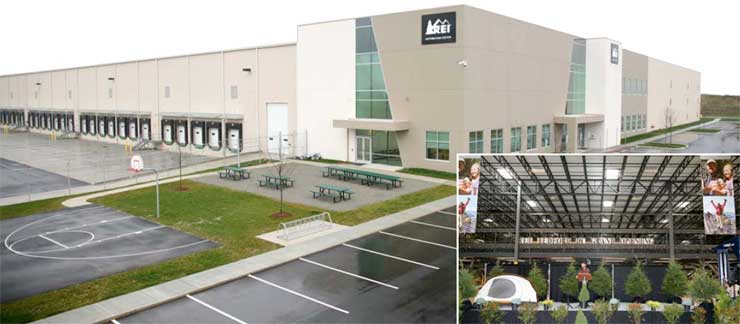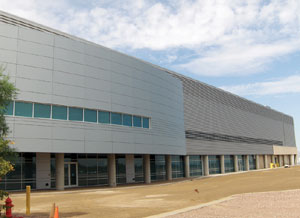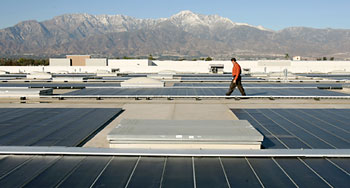
n coming years, it may not be that far-fetched to observe a range of products from traditional manufacturing industries supporting the job-creating potential of their former service providers in environmental services, energy management and green building.
Such is the powerful, cycle-changing influence of the green imperative now striking at the heart of multinational corporate strategy – and at the hundreds of millions of square feet in facilities and millions
of acres those multinationals manage.
Some companies are going beyond modifying their own footprints. In announcing his energy-consuming company’s renewable energy initiative in late November, Sergey Brin, Google co-founder and president of technology, said, “Cheap renewable energy is not only critical for the environment but also vital for economic development in many places where there is limited affordable energy of any kind.”
afterwards our buildings shape us.”
The Google program, called “RE
Google’s green goals are inward as well. On track to be carbon-neutral by the end of 2007, the company has invested in a 1.6-megawatt corporate solar panel installation (pictured) that supplies electricity for its entire Mountain View, Calif., campus. It’s also developed new technologies to operate and run its data centers around the world
Data centers are known power munchers. But some are suggesting that a truly green strategy will work its way into the data itself. Launched in September 2007, The Green Data Project, a joint venture of the Data Management Institute and Archive Management.org (AMO), aims to reduce useless data in order to reduce the power required to manage it.
Citing presumably green statistical data from Sun Microsystems, Jon William Toigo, founder of both Data Management Institute and AMO, said only about 30 percent of hard disk space is storing information that is business-relevant or frequently accessed. Forty percent of that space, meanwhile, is given over to data that could be stored in ways that consume little or no electricity. The other 30 percent, said Toigo, is dedicated to contraband or orphaned data.
“Green IT must begin with green data,” said Toigo. “Otherwise a company’s data center greening initiative amounts to little more than rearranging deck chairs on the Titanic.”

Icebergs may not be a problem soon, however. Yet more data released in early December showed that the Arctic melt is occurring much faster than even the most pessimistic scientists had projected just last year.
Emissions from coal-fired power, which supplies 40 percent of the world’s electricity, are widely judged to be a chief cause of such warming. China is currently building more than 500 new coal-fired plants to add to its existing portfolio of more than 2,000. They in turn are chiefly responsible for the great cloud of soot spotted floating toward North America in late 2006. For many, it was a quite literal case of the sky falling.
The bill for making China the world’s factory is therefore likely to come due sooner rather than later. And it could shake site selection fundamentals to their core.
“Can you say you’re manufacturing on a green platform if, rather than manufacturing domestically and shipping products 600 miles to the customer base, you’re shipping 4,000 miles and bringing product halfway around the world, with all of the requisite fuel consumption for air, ship, rail and intermodal?” asks Gregg Wassmansdorf, vice president and manager of Colliers International’s Location Advisory & Incentives Practice. “And if you’re doing it in places like China, where the environment is deteriorating, how does that fit into a green strategy?”
He says the next big wave will be how to turn your company green in a global context. And despite the bad environmental news, he does see some signs of hope in the developing world.
“When I was in India in April and May, it was satisfying and comforting to see best-in-class technologies from Europe and North America actually being implemented there and exceeding local requirements. That’s the only way that, in the net, you can make it better.”
Charlie Allcock, director of economic development for Portland General Electric in Oregon, says corporate sustainability has gone from a social imperative to just smart business. And he thinks putting

production closer to end markets is one way it’s going to play out.
“You’re going to see that trend beginning to happen from both a carbon footprint standpoint and a time-to-market standpoint,” he says. “Right now, if you make a product on the other side of the Pacific Ocean, it’s in a container on a ship and basically floating on the ocean for 30 to 60 days. If your markets are moving fast, you have two choices – ship by air, or eat the time that the product is in transit. Combined, it begins to say ‘Let’s bring some manufacturing closer to where it’s going to be used’ or ‘Let’s bring farming back closer to where the product is going to be consumed.’ “
China is not ignoring its export-related pollution, especially as it tries to clean things up for the 2008 Olympic Games. In October 2007, the People’s Republic’s State Environmental Protection Administration introduced more stringent pollution regulations that, if violated, could force operations to simply shut down for between one and three years.
That nation’s poor air quality may in fact inspire environmental projects there, especially as multinationals try to reduce their multinational carbon footprint.
“There are the traditional ROI criteria, but today a calculation on a project’s contribution to reducing our carbon footprint may weigh more heavily,” says one environmental and sustainability executive of worldwide green analysis. “If I had a project that reduces an equivalent number of kilowatt-hours in Texas or China, the China project would have a greater impact on the carbon footprint because energy is dirtier there.”
Might increased environmental awareness among corporations contribute to an eventual overall reduction in environmental permitting-related lawsuits and legal tussles, or will it lead to more issues, as new rules and regulations are promulgated in this arena? Martin A. Shelton, a partner at Atlanta-based Schulten Ward & Turner who heads up the firm’s environmental law section, says, “Though many companies, especially the larger corporations, are quickly becoming more pro-environment or at least following a greener agenda, I do not see a significant decline in such litigation in the immediate future.
“Even those with the best intentions still mostly only do what is necessary to meet minimum standards,” he says. “Cost is always an issue of compliance, and as long as enhanced compliance is more expensive, I think you will continue to see litigation.”
Bill Adams, automotive industry specialist for the Tennessee Valley Authority’s economic development team, says another factor is rising to the green world’s surface:
“Water is going to be a huge site location variable in the future,” he says. “Not just having plenty, but having it without a lot of contaminants. Silica is a no-no, iron is a no-no. In areas of the world where you’re hitting the water tables, the consistency of the water changes – more sand, more lime, more iron. So it really does affect the on-site treatment at the plants.”
Conserving H2O is central to the corporate real estate mandate.
“Of late, we are starting to look at greatest impact in terms of reducing water consumption,” says one high-tech environmental and sustainability executive.
In December, Intel Corp. and PepsiCo‘s Frito-Lay division were the only private companies honored by the U.S. Environmental Protection Agency’s 2007 Water Efficiency Leader Awards program. Frito-Lay has used internal awareness, training and accountability to reduce its U.S. water consumption per pound of product by 39 percent since 1999.
Intel’s Ocotillo campus in Chandler, Ariz., aims to recycle 75 percent of the water used annually during manufacturing. The program includes internal reuse of 530 million gallons of water within the plant, the take-back of 825 million gallons of treated wastewater from the city’s wastewater plant and treatment of 575 million gallons of water to drinking water standards that are then returned back to the local underground aquifer.
Dave Stangis, director, corporate responsibility for Intel Corp., says in an interview that the company’s goals for energy use and its carbon footprint are part of how the company does business and designs its processes.
“When it comes to site selection, there is a whole portfolio of things you look at that can affect that,” he says. “Supply chain, employees being close by, infrastructure, and also sources in terms of clean water and reliable energy. When we put one of our factories down – which can be hundreds of millions of dollars on the low end and billions on the high end – even proximity has a huge impact on the carbon footprint.”
The company has won the EPA’s “best places to work for commuters” award for three years running. Intel is beginning to closely measure the environmental impact of its commuting and shipping patterns, he says, all of which “comes into play when we do our site selections. Supply chain management is really starting to ramp up” as an area of environmental focus.
The company’s position “right smack dab in the middle of the supply chain” means Intel is being asked about its carbon footprint by customers and simultaneously asking the same question of its suppliers.
“There will be more and more emphasis on who owns the right to claim reductions,” he points out. “If my chip uses energy, but then is integrated into another electronic product, should that product be able to claim it too?”
The company’s first LEED building was its design center in Israel, says Stangis. Intel is helping others build more efficient centers around the globe, using products such as its EcoRack as well as design lessons it’s learned in such areas as air flow and heat reduction.
It’s a macro manifestation of Moore’s Law: As the making of tinier and tinier products has run up against issues of heat and energy management, so too do the company’s own buildings confront similar challenges. The company for years has won awards for its energy optimization measures, such as efficient chillers or waste heat reuse. It’s just that now it’s starting to talk about it more.
“One of the things we do well is learn as an organization,” says Stangis, whether the lessons are coming from fabs in Oregon, Arizona or Israel.
“When we design a factory, we have a whole team of environmental engineers sitting around the table and setting goals for water use,” says Stangis. “Then what we’re able to do is take a look at how we can optimize water or energy use for the local municipality. In Arizona we’re able to recycle billions of gallons of water, at a facility we built for the city. Israel has a zero-discharge approach, where they want to wring out every drop they can. They find ways to use it for agricultural irrigation. Back in Arizona, we take gray water from the city at part of our inlet. We learn from site to site and build it into future generations.”
The company’s quarterly environmental operations reviews present another opportunity to bring in data from all sites showing side-by-side numbers for water and energy use, waste generation, heating and cooling and pump efficiency at each fab.
Stangis says Intel’s site selections have always been helped by taking a holistic approach that incorporates not only environmental engineers but public affairs specialists who factor in water scarcity and climate change in addition to the usual due diligence issues.
Intel also draws sustenance from its participation in multiple trade and industry groups such as the Green Grid group, the Climate Savers Computing Initiative, Sematech and the Semiconductor Industry Association, which provides the company with blind benchmarking data drawn from the operations of every U.S. semiconductor company.


Different territories are figuring out just how to shape their green incentives policies –

or in some cases, offering nothing yet requiring stricter standards as a matter of principle.
One consultant tells of asking a state whether there were incentives for cutting-edge environmental technologies as part of a major industrial project. The state displayed interest, but produced no concrete policy.
“Miller Starr Regalia is not seeing ‘green incentives’ per se, but rather more and more requirements from cities, including San Jose, looking to establish measures in sustainable building codes for builders,” says transactional shareholder Wilson Wendt of Miller Starr Regalia’s Walnut Creek, Calif., law office.
Some cities such as Portland, Ore., are going so far as to propose new carbon taxes, which would tax builders who comply with the state’s strict codes and only reward them when they exceed that code’s standards by 40 percent.
A search by Site Selection of the U.S. Green Building Council public policy database revealed a total of 215 measures adopted at the city, county, regional or state level. However, most of those policies target governments themselves, holding their facilities to a LEED standard.
When it comes to LEED incentives or requirements for private-sector buildings, only 40 policies surface across North America, with 12 implementing requirements with no enticements other than a clear conscience, 22 others allowing for such niceties as tax abatements or credits, greater density, expedited permitting or permit fee reduction and loans; and six jurisdictions (including Calgary, L.A. and Washington, D.C.) offering some combination of requirements and incentives.
Internationally, in addition to the clear leadership already evident throughout Europe in places such as Germany, Singapore is making an effort to establish itself as a clean energy hub, most recently pledging $50 million toward R&D in the area, while also welcoming a potential $4.3-billion investment from Norway’s Renewable Energy Corp. in the world’s largest integrated solar manufacturing complex.
In Dubai and other Arab territories, in a compensatory development, green cities and corporate complexes are sprouting even as the region seeks to deepen and diversify its industrial profile. While new smelters and other heavy industry are locating in the area, green projects such as Dubai Biotechnology and Research Park (DuBiotech) continue to win praise. DuBiotech’s Bio HQ recently won the Design and Sustainability Honour Award from the American Institute of Architects (AIA) New Jersey Chapter.
Intel, like any other company, looks for all the tax credits and other supportive policies it can for its green projects. But it also makes its own adjustments.
“Every publicly traded U.S. company needs to do things that make fiscal sense, not just PR sense,” he says. “Where we can back those into an ROI analysis, it really does help. Any time business can find an opportunity to save costs while driving environmental improvements, they’ll do that.
“But a lot of companies are looking at their payback period and maybe stretching that when it comes to environmental projects,” he says. “We have a capital fund associated with energy conservation projects that has a more relaxed ROI equation,” he says, “so we’ve been able to fund $20 million to $30 million worth of energy projects, and get a payback we wouldn’t have been able to get if we had a much shorter or tighter ROI hurdle.”
Once the province of engineers, energy efficiency and environmental impact are now the playthings of many a corporate department, including marketing. Asked how PR value now comes into play, one executive says there’s no question that his firm and others “are doing certain projects for leadership demonstration. ROI isn’t irrelevant, but it’s given less weight than otherwise. But for
That said, the ROI remains very real.
“We’re really looking high and low across the entire operational footprint,” including pegging certain facility projects at a LEED-Gold standard or its international equivalent from the outset, he says. “Every project like that is an opportunity lost if you don’t look at it like that from the very beginning.”
Site Selection Online – The magazine of Corporate Real Estate Strategy and Area Economic Development.
©2008 Conway Data, Inc. All rights reserved. SiteNet data is from many sources and not warranted to be accurate or current.
